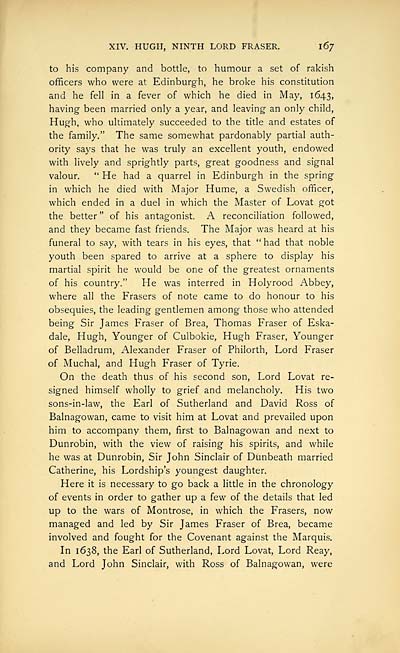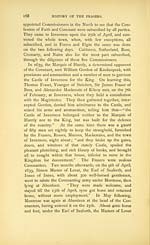History of the Frasers of Lovat
(187) Page 167
Download files
Complete book:
Individual page:
Thumbnail gallery: Grid view | List view

XIV. HUGH, NINTH LORD FRASER. 1 67
to his company and bottle, to humour a set of rakish
officers who were at Edinburgh, he broke his constitution
and he fell in a fever of which he died in May, 1643,
having been married only a year, and leaving an only child,
Hugh, who ultimately succeeded to the title and estates of
the family." The same somewhat pardonably partial auth-
ority says that he was truly an excellent youth, endowed
with lively and sprightly parts, great goodness and signal
valour. " He had a quarrel in Edinburgh in the spring
in which he died with Major Hume, a Swedish officer,
which ended in a duel in which the Master of Lovat got
the better" of his antagonist. A reconciliation followed,
and they became fast friends. The Major was heard at his
funeral to say, with tears in his eyes, that " had that noble
youth been spared to arrive at a sphere to display his
martial spirit he would be one of the greatest ornaments
of his country." He was interred in Holyrood Abbey,
where all the Frasers of note came to do honour to his
obsequies, the leading gentlemen among those who attended
being Sir James Fraser of Brea, Thomas Fraser of Eska-
dale, Hugh, Younger of Culbokie, Hugh Fraser, Younger
of Belladrum, Alexander Fraser of Philorth, Lord Fraser
of Muchal, and Hugh Fraser of Tyrie.
On the death thus of his second son, Lord Lovat re-
signed himself wholly to grief and melancholy. His two
sons-in-law, the Earl of Sutherland and David Ross of
Balnagowan, came to visit him at Lovat and prevailed upon
him to accompany them, first to Balnagowan and next to
Dunrobin, with the view of raising his spirits, and while
he was at Dunrobin, Sir John Sinclair of Dunbeath married
Catherine, his Lordship's youngest daughter.
Here it is necessary to go back a little in the chronology
of events in order to gather up a few of the details that led
up to the wars of Montrose, in which the Frasers, now
managed and led by Sir James Fraser of Brea, became
involved and fought for the Covenant against the Marquis.
In 1638, the Earl of Sutherland, Lord Lovat, Lord Reay,
and Lord John Sinclair, with Ross of Balnagowan, were
to his company and bottle, to humour a set of rakish
officers who were at Edinburgh, he broke his constitution
and he fell in a fever of which he died in May, 1643,
having been married only a year, and leaving an only child,
Hugh, who ultimately succeeded to the title and estates of
the family." The same somewhat pardonably partial auth-
ority says that he was truly an excellent youth, endowed
with lively and sprightly parts, great goodness and signal
valour. " He had a quarrel in Edinburgh in the spring
in which he died with Major Hume, a Swedish officer,
which ended in a duel in which the Master of Lovat got
the better" of his antagonist. A reconciliation followed,
and they became fast friends. The Major was heard at his
funeral to say, with tears in his eyes, that " had that noble
youth been spared to arrive at a sphere to display his
martial spirit he would be one of the greatest ornaments
of his country." He was interred in Holyrood Abbey,
where all the Frasers of note came to do honour to his
obsequies, the leading gentlemen among those who attended
being Sir James Fraser of Brea, Thomas Fraser of Eska-
dale, Hugh, Younger of Culbokie, Hugh Fraser, Younger
of Belladrum, Alexander Fraser of Philorth, Lord Fraser
of Muchal, and Hugh Fraser of Tyrie.
On the death thus of his second son, Lord Lovat re-
signed himself wholly to grief and melancholy. His two
sons-in-law, the Earl of Sutherland and David Ross of
Balnagowan, came to visit him at Lovat and prevailed upon
him to accompany them, first to Balnagowan and next to
Dunrobin, with the view of raising his spirits, and while
he was at Dunrobin, Sir John Sinclair of Dunbeath married
Catherine, his Lordship's youngest daughter.
Here it is necessary to go back a little in the chronology
of events in order to gather up a few of the details that led
up to the wars of Montrose, in which the Frasers, now
managed and led by Sir James Fraser of Brea, became
involved and fought for the Covenant against the Marquis.
In 1638, the Earl of Sutherland, Lord Lovat, Lord Reay,
and Lord John Sinclair, with Ross of Balnagowan, were
Set display mode to:
![]() Universal Viewer |
Universal Viewer | ![]() Mirador |
Large image | Transcription
Mirador |
Large image | Transcription
Images and transcriptions on this page, including medium image downloads, may be used under the Creative Commons Attribution 4.0 International Licence unless otherwise stated. ![]()
| Histories of Scottish families > History of the Frasers of Lovat > (187) Page 167 |
|---|
| Permanent URL | https://digital.nls.uk/96581436 |
|---|
| Description | A selection of almost 400 printed items relating to the history of Scottish families, mostly dating from the 19th and early 20th centuries. Includes memoirs, genealogies and clan histories, with a few produced by emigrant families. The earliest family history goes back to AD 916. |
|---|

